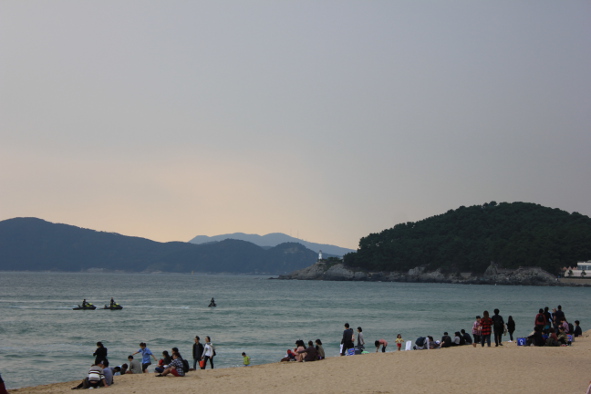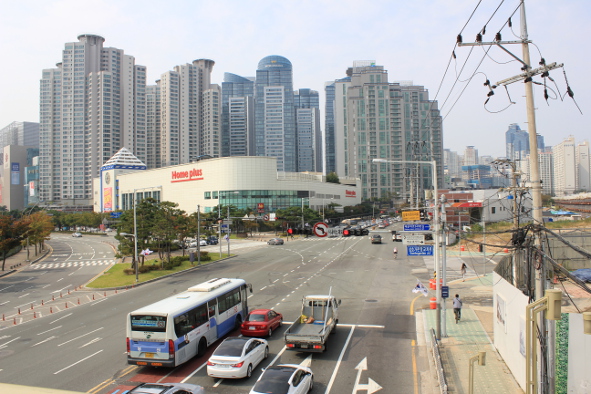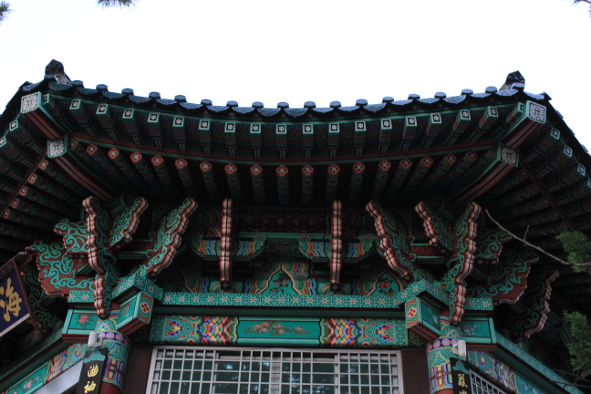The main tourist draw in Busan – South Korea’s second largest city – is Haeundae Beach, a district filled with gorgeous natural wonders, aging cultural attractions and impressive upscale shopping destinations. A stroll through the area is a fascinating experience for both its glamorous modern façade and for the long-held cultural traditions evident just beneath the surface.
A Korean-American friend of mine remarked that spending a weekend in Busan’s popular Haeundae Beach neighborhood isn’t much different than spending a weekend in the Koreatown neighborhood of Los Angeles.
I understood her point, as I walked away from the beach and along the main drag of Gunam-ro, where I spotted a Baskin Robbins nestled between a KFC and something called Breeze Burn’s, all spelled in English and all occupying the bottom floor of a towering office building.
Like so much of South Korea, Haeundae Beach was forever transformed during the nation’s rapid modernization in the second half of the twentieth century, a period called the Miracle on the Han River for the river which flows through capital city Seoul.
The Miracle created a Busan wherein Buddhist temples and hillside shantytowns exist in the shadow of impressive skyscrapers. Haeundae Beach might be changed from Korea’s economic growth, but it’s more than a glorified Koreatown. It is a fascinating neighborhood of timeless beauty and modern contradictions. A place where the city meets the sea and where the nation meets its future.
The Beach
Haeundae Beach is perhaps the most popular beach community in the entire nation of South Korea, so both domestic and international tourists tend to flood this stretch of sand for months during the summer peak season.
I visited in late fall, so the beach was more peaceful, still populated with visitors and locals alike milling about on the sand. It was a beautiful view from the shore, the southern Japanese islands looming mysteriously through the mist only a few dozen miles away.
Depending on what mood I was in each day, the beach itself was the perfect spot to relax and to either watch the waves or watch the people. It was calming to see the big ocean swells crash against the fine sand, releasing a refreshing whiff of saltwater each time, just as it was entertaining to see the people wandering by or occasionally spot a street performer.
Once, as I was kicking up sand and traversing the shore around sunset, I came upon an ocarina player. The fragile wind instrument emitted the most delicately beautiful melodies in his well-trained hands. I was so moved by the sight of the sunset and the sound of him playing this simple, ancient instrument in such a modern setting I gave up a few thousand won (South Korean currency) for his time.
The Modern Haeundae
I watched the waves coming from the untouched islands surrounding the area before making a one-eighty degree turn and finding myself in a different world entirely. Haeundae is more than a beach—it’s the epicenter of Busan’s growth into a world of digital technology and sleek steel skyscrapers.
I skipped the familiar American shops and headed for the Shinsegae Department Store, which holds the Guinness World Record title for the world’s largest department store. Rather than lose myself in the retail shops, I found myself in a novel culinary heaven at their basement food court, where one can freely browse between authentic sushi and Korean barbeque spots alongside ill-advised attempts at Italian and Mexican food.
I tried the Italian food once, and immediately regretted the decision. For the remainder of my trip, I stuck to the local cuisine (bibimbap, hot pots, fried fish, Korean barbeque, etc.), and was repeatedly delighted, albeit confused, by the Eastern dishes and presentations.
The Department Store also holds the massive Centum Spaland, an upscale Korean spa that works hard to be the most accessible to international visitors. Rather than wonder about the expectations of the Korean spa experience, I showed up to Spaland before 8 a.m. to take advantage of the early morning discount and made sure to leaf through their English brochure a few times before entering the locker rooms—I didn’t want to be nude when I wasn’t supposed to, after all.
Given the four hour time limit to take advantage of the seemingly endless Spaland accommodations, I only ended up staying for two-and-a-half. While others will surely be entranced by Spaland’s vast selection of distinct saunas and steam rooms, I was too time-conscious to enjoy the place while I wondered about the more authentic cultural sights I could be experiencing outside of this impressive but monotonous sauna.
The Old Haeundae
While Shinsagae Department Store brings traditional Korean cuisine into a sprawling shopping mall setting, the conveniently located Haeundae Market offers a more striking cultural experience by offering fresh foods in a street-side venue.
I spotted the Market’s colorful archway just a couple blocks from the beach and immediately knew I had stumbled upon something special when I entered and was overpowered by the smell of fresh-caught seafood.
I followed the stone alleyways through dense clusters of pop-up shops selling clothes and authentic street food dishes, the unfortunate fishy smell occasionally drowned out by the smoke from some delicious barbeque restaurant.
Of course, I made a stop and enjoyed some of the Korean beef, sliced up and cooked with roughly two thousand side dishes right at my table. I ordered Soju as well, an excessively popular Korean liquor that tasted like water but went down my throat like fire. I learned the hard way that a night of Soju consumption makes for a morning of misery.
Haeundae Market gave me a taste of traditional Korean urban culture with some vibrant modern flair, but I would have to venture farther from the famous beach to see the bits of Korean culture so often eclipsed by modernization.
On the bus ride and on the walk to the Yonggungsa Buddhist Temple, unusually situated beside the ocean instead of in the mountains, I saw plenty of the less-polished side of Busan—dilapidated houses, urban gardens overtaken by hilly wildlife, shantytown-like communities, areas that had been forgotten in the midst of so many skyscrapers.
It was sad to see, but fascinating too. Of course, nothing was quite as fascinating on my journey as it was at my destination. The Yonggungsa temple is a vibrant place of worship for both its multicolored archway architecture and its cliff-side location. I wandered from stone sculptures onto rugged natural pathways of rock extending partway into the water, unperturbed by the multitude of other tourists exploring the temples.
In spite of the tourists and in spite of the modernization, I saw stray bits of pre-Miracle Korean culture lurking about in Busan’s Buddhist temples. A woman did tai-chi standing atop a remote, partly submerged stone. A group of women sorted through a massive cart of cabbage to make kimchi. A robed monk rung a bell rhythmically and sung a prayer song as he gazed upon an enormous golden Buddha statue.
In its race towards economic supremacy, Korea has lost some of its ancient charms, but I took comfort here, seeing some cultural traditions that will likely never disappear, no matter how many more skyscrapers and KFCs they erect.




